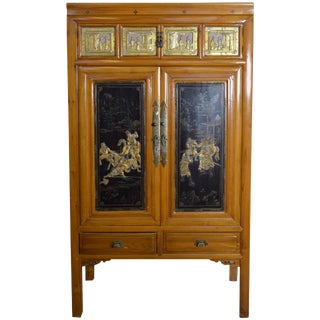Clever storage is always en vogue — hence the endless timeless appeal of armoires and wardrobes.
Wardrobes and armoires have been relatively constant fixtures since Medieval times.
Why?
These weighty, free-standing cabinets have endured for centuries thanks to their abundance of storage — something that humans have needed throughout the centuries. They were originally designed to store linens and other essentials.
The design of the wooden wardrobe and armoire features the classic two French-style doors that open to reveal a hanging bar for clothes.
Antique Wardrobes at Chairish
Here at Chairish, we have no shortage of amore for the versatile vintage armoire. If you’re on the hunt for an armoire for sale, there’s no better place to start your search!
Whether you’re looking to track down an antique armoire in a traditional [French Provincial(https://www.chairish.com/collection/armoires-wardrobes-and-linen-presses/french-provincial) style or you have your heart set on a 1970’s polished burlwood design, we likely have something to fit the bill at Chairish.
Discover antique wardrobe designs in classic and popular styles, including:
Swedish Rococo
For modernists, our vintage wardrobe offerings include designs outfitted in high-design materials like pencil reed, lacquer and wicker.
Shop vintage armoires for sale that include the best designs from beloved brands like Hendredon, Mastercraft and Thomasville.
Before you head off for some happy antique armoire shopping on our website, here’s a little more information about how these sought-after wardrobes came to be.
The History of the Armoire
The armoire closet has undergone many iterations since its inception.
In the Middle Ages, these designs were known as “presses.” Similar to the models of today, presses were used for stashing clothing, including robes.
In Italy, the concept transformed into the linen press and in the Netherlands, the “kast,” which was essentially a huge cupboard. In France, they became a place to stockpile weapons and defense gear.
The current iteration of the wooden wardrobe — the large, free-standing cabinet intended to function as a makeshift closet that we know and love today — surfaced in France in approximately the 17th century.
The Armoire in Modern Day
Beginning in the 1980s, wardrobes began breaking out of the bedroom and taking on more tech-driven tasks. Namely to house hardware like TVs and computers.
When TVs and computers underwent a slim-down in the late 2000s, these wooden wardrobes were cast aside in droves.
For a short time, it seemed plausible that the armoire closet had seen its day. And yet, the quest to curb clutter never ends.
In contemporary times, armoires and wardrobes have been reimagined as a trimmer, more compact version of the standing closet. Special details like caning, parquet inlays and even glass-paned doors have ushered in a new era for the antique wardrobe.
Their shapes have also transformed. Rather than a standard-issue box, many models are coming to market with domed tops, a design element that helps to soften their overall appearance.
Frequently Asked Questions
What is the difference between an armoire and a wardrobe?
An armoire is a tall, free-standing cabinet with doors and shelves, while a wardrobe is typically a closet built into the wall. Armoires are usually more ornate and decorative than wardrobes, and they are often used to store clothing, linens, or other household items.
How can you tell how old an armoire is?
One way to determine the age of an armoire is to look at its construction and materials. Antique armoires may have hand-cut dovetail joints, while newer pieces may have machine-cut joints. Additionally, the type of wood and hardware used can provide clues to the armoire's age.
How big should an armoire be?
The size of an armoire depends on its intended use and the space available in the room. A typical armoire ranges from 36 to 60 inches wide, 60 to 72 inches tall, and 18 to 24 inches deep.
What is the average depth of an armoire?
The average depth of an armoire is between 18 and 24 inches. This depth allows for the storage of clothing on hangers or folded items on shelves while still fitting comfortably in most room layouts.
Why are armoires so expensive?
Armoires can be expensive due to the quality of materials used, such as solid wood construction and decorative elements like intricate carvings or high-end hardware. The craftsmanship involved in creating an armoire also contributes to its higher price point compared to other storage furniture.
What furniture is similar to an armoire?
Furniture pieces similar to an armoire include wardrobes, chifforobes, and entertainment centers. These items all provide storage space for clothing, media, or other household items and often feature doors, drawers, and shelves to help keep things organized.
Related Collections
- New & Custom Armoires & Wardrobes
- Large Armoires With Shelves and Drawers
- Arched Armoires
- Boho Armoires
- Carved Armoires
- White Oak Armoires Wardrobes and Linen Presses
- Copper Armoires Wardrobes and Linen Presses
- Wood Armoires With Drawers
- Distressed Armoires
- Far Pavilions Armoires Wardrobes and Linen Presses
- Solid Wood Armoires
- Marble Armoires Wardrobes and Linen Presses
- WK Möbel Armoires Wardrobes and Linen Presses
- Cabin Armoires Wardrobes and Linen Presses
- French Armoires Wardrobes and Linen Presses
- Thomasville Armoires Wardrobes and Linen Presses
- Ethan Allen Armoires Wardrobes and Linen Presses
- Linen Armoires
- Pine Armoires
- Teak Armoires Wardrobes and Linen Presses
- Mid-Century Modern Armoires Wardrobes and Linen Presses
- French Country Armoires Wardrobes and Linen Presses
- Mirrored Armoires
- Oak Armoires
- Baker Furniture Company Armoires Wardrobes and Linen Presses























































